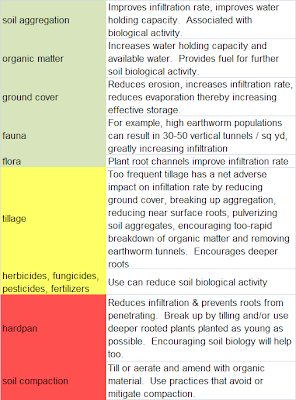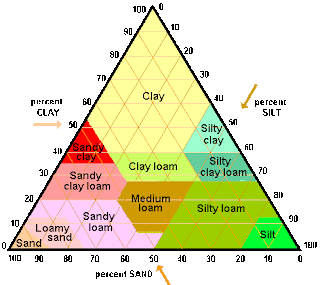It turns out that there's a useful level of understanding for gardeners a step or two above the cavemanese or dummy level. While there's plenty of web information on the necessity of mulching and composting those articles are are often little better than my cavemanese since they don't provide a scientific or evidence-based rationale. I'll try to leave that sort of writing for the garden mulch sycophants, color-by-number recipe followers, and garden hangers-on and instead give you a little bit of an empirical soil science rationale behind the seven pillars of garden soil maintenance.
Were you aware that "loam" is just a word to describe a particular mixture of mineral particle sizes of your soil (soil texture)? I guess I read too many pioneer farmer stories in my youth, where they tilled the "rich loamy soil", and consequently I thought until recently that loam had copious amounts of organic material in it. It doesn't. Let me repeat more loudly: LOAM DOES NOT HAVE ORGANIC MATERIAL IN IT. Neither does clay. Nor does silt.
As it turns out I could be excused for misunderstanding loam, since in common usage, loam can mean that organic material is incorporated. For example, if one types "define: loam" in Google, the very first definition is from no less an authoritative source than Princeton, who state that loam is "a rich soil consisting of a mixture of sand and clay and decaying organic materials". Apparently Princeton is not quite the voice of authority in the garden, where we definitely do not include organic material in our understanding of soil texture.
Loam is a particular kind of soil texture described by a particular the ratio of sand, silt and clay. Sand, silt and clay are the mineral content of your soil. Sand, silt and clay are all mineral in makeup and are discriminated by size and shape. They also (generally speaking) do not absorb water. Rather, the water holding capacity of sand, silt or clay is due to the spaces between the soil particles. Scientists might call these the interstitial spaces. Sand is the largest size range from greater than 50 microns and up to 2mm. Silt is between 2 and 50 microns and clay is the smallest at 2 microns or less. 1 micron = 0.001 mm.
This hadn't really sunk in even when I blogged previously about my Ocean Friendly Garden class and threw up a graphic of a soil triangle (ternary phase diagram for soils), reproduced below.
Loam is about 40% sand, 40% silt, and 20% clay. Remember that there's only mineral constituents on this phase diagram -- no organic material. Since loam is on this phase diagram, loam can not have organic material in it. The nice thing about soil texture is that it is immutable: Whatever soil texture you have in your garden, it will always be the same during our lifetimes, unless you cart in new soil. Thus soil texture is the starting point for any garden soils analysis.
You can figure out your soil texture using the mayonnaise jar test. Knowing your soil texture is important because it will give you some guidelines about how quickly water can infiltrate the soil, how much can be retained for use by plants, and how quickly it will percolate out of your soil. You and I don't have to guess about what these various figures of merit are, since soil scientists have already done that work. Here's a table that I built as a summary of their prior work.
 |
| Total water, available water, and infiltration rate ranges based on soil texture alone. Good soil management practices will improve these figures. |
A note on units: The units "inches of water per foot of soil" means that if I have a 1 foot depth of that soil type then I can store water equal to the given number of inches per unit area. For example, in sandy loam I can store 1.9 inches of water (per sq foot or per square meter or per square hectare) if the sandy loam soil goes to a depth of 1 foot. For two feet depth I can store 3.8 inches of water. I'm asserting this as if I'd invented the units, but really it's what I've puzzled out after finding lack of clarity on the web in the several places I looked. Nonetheless, I think I'm right.
Here in Los Angeles' South bay we tend to have either very sandy soil from ancient dunes or one of the clay soils from the marsh and wetlands that used to exist here. Depending upon how much fill soil you have, you could have both on your property as I do.
So far, we've been talking about the properties of sterile soil without organic material in it. Your soil undoubtedly has at least some organic matter and that increases total water, available water and infiltration rate. Better soil management practices can additionally increase those figures. For example, larger amounts of organic matter in the soil are also associated with high biological activity which is also associated with good soil health. A list of soil characteristics and practices that influence water retention and infiltration is provided below. The color coding indicates my assessment of degree of improvement.
 |
| Soil characteristics and practices that influence water retention and infiltration in soil. |
I don't know that I'm hard and fast on all the color codes but what I do know is that there are measurable improvements for organic material and ground cover. In fact, the top seven items in that table could be considered useful, or possibly useful, to your soil. I might be accused of indulging in numerology if I made more of the fact that there are seven pillars of gardening just like there are seven pillars of Ismailism and that as I was going to St. Ives I met a man with seven wives.
Here's what the data says about mulching and soil organic content impact on water retention and infiltration:
 |
| Mulch increases water infiltration rate. From http://attra.ncat.org/attra-pub/drought.html. |
Egads! tons per acre? Not to fear: Straw mulch applied at a rate of 1/2 to 3 tons of mulch per acre gives a depth of 1/2 to 1 inch according to this reference. Scientists use straw mulch because it's cheap and widely available, the depth is uniform and easily controlled, and because farmers would use it too. We'll make an engineering approximation that the convenient straw mulch cited above applies equally to all mulches and to all soil textures, which means that you could add about 1" of any mulch (leaves, bark, or whatever meets your aesthetic needs) to get a factor of ~2.5 increase in water infiltration rate. As a point of reference, native plant experts recommend 3" of mulch on bare soil, though their goals are also to provide weed abatement and reduce soil temperatures and water loss from evaporation. [SIDE NOTE: Why do mulches increase infiltration rate? Although I'm an empiricist for purposes of this article, I'll speculate that mulches prevent near surface compaction from rain, prevent migration of light soil components that could fill outer layer infiltration points, and provide an intimate "kissing" contact that reduces surface tension effects on water flow.]
 |
| Organic matter increases water retention. From http://attra.ncat.org/attra-pub/drought.html. |
Now let's imagine that I till in 5% organic matter by weight into the top foot of my thin, compacted soil. Then not only have I relieved the soil compaction by tilling, but I also have the benefit of that 5% organic matter. I'll let the biology gradually return to feed on that 5% organic matter, provided I don't kill it by overfertilizing, over tilling, or one of the 'cides. According to the graph above, that 5% organic matter is good for about 37% more water retention. We might expect more improvement based on the biological activity and soil beneficial aggregation that will follow. Of course, you'll have to renew the organic material periodically as it degrades, but you should remind yourself that this activity that you're doing is called gardening, not "getting a massage while sipping a cold drink".
Suppose I also top the soil with 1 inch of bark mulch or grow a cover crop such as turf grass for a factor of ~2.5 increase in infiltration rate due to mulching effects. We know that the existence of roots will further improve infiltration rate, but I haven't found data on that. I also don't have data on the impact of beetles, earthworms and the like, nor on soil aggregation. Let's assume a 20% improvement in infiltration rate for these unknown factors - this is soil science not rocket science. What else do I need to do to maintain or improve soil health and therefore improve water infiltration and retention? One thing that I have to do is in areas where people or animals walk (turf grass, in particular) I'll need to periodically aerate to remediate compaction from walking.
The bottom line is that if I keep my soil healthy, then water retention and water availabilities could go up by a factor of 1.37 and infiltration rate could go up by a phenomenal factor of 2.5*1.20 = 3.0 from the values indicated in the soil texture table. Suppose you're not happy with only 37% increase in water retention. Then add more organics.
Hopefully you now feel like you're a leg up on the Dummies folk and have a better understanding of why we ought to add compost and mulch and why we build our soil's health by practicing good soil management. And who says there's no better living through science?
updated 9 Feb, 2011 to correct some typos and add a bit more clarity.
Sources around the web varied slightly in their exact numbers. I liked the good soil information on http://attra.ncat.org/attra-pub/drought.html, which I summarize here. I use a couple of their figures as well. I also used some other facts and figures http://turf.arizona.edu/tips1095.html.

No comments:
Post a Comment